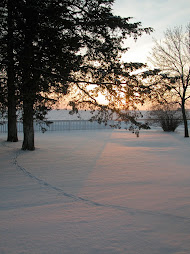Another benefit of not having little ones around to busy up the holidays is that it allows more time to ponder the “reason for the season.” Easter, of course, is a celebration of Christ’s (and our own eventual) triumph over death. It also closes out the period of Lent when, hopefully, we’ve been working on the penitential journey toward becoming a better person – more Christ-like. It also makes it easier, slightly easier, to get to those Holy Week services at Church.
So for those of us currently (but hopefully not eternally) without little ones to infuse chaos into our holidays, the calm is welcome. Life, after all, offers plenty of opportunities to encounter stress. Entertaining is easier too; the food and conversation can move to the center of the Easter banquet. Then again, as I look out the window at our second consecutive day of snowfall, I recall with fondness those hectic holidays. And, I think about bunny tracks.
When our children were little, hubby and I fleshed out the Easter Bunny myth for them each year by doing more than simply filling and hiding their Easter baskets; we spread white bunny tracks all through the house using flour. Each Easter Saturday eve, after the kids went to bed, we tracked through the house with homemade paw print stencils and a sifter full of flour, spreading tracks all over the floors. The next morning, the children dashed around at dawn following each track to its end, where a stash of sweet treasure was to be found.
The flour tracks, of course, represented snow that Easter Bunny carelessly carried inside while delivering treats; the kids never seemed to notice that these white tracks appeared even on Easter mornings when temps were in the 40s and 50s and there was no snow to be found anywhere in the state. The myth played out for all of us.
Of course, spreading flour all over your house does add a bit of added work to an already busy day. Somehow, though, the expressions on the faces of your bunny-enamored youngsters make the mess more than worth it. Recalling my children's faces, their sheer exuberance over it all, leaves me wishing I could trade this now-quiet holiday in for a chaotic one, if even for a little while. Happy Easter to all.
Our Easter morning in 1982. Note the bunny tracks circled in yellow.
Before Macy's, before Marshall Fields, was the Dayton's annual
Breakfast with the Easter Bunny! I'm guessing this was in 1992.








